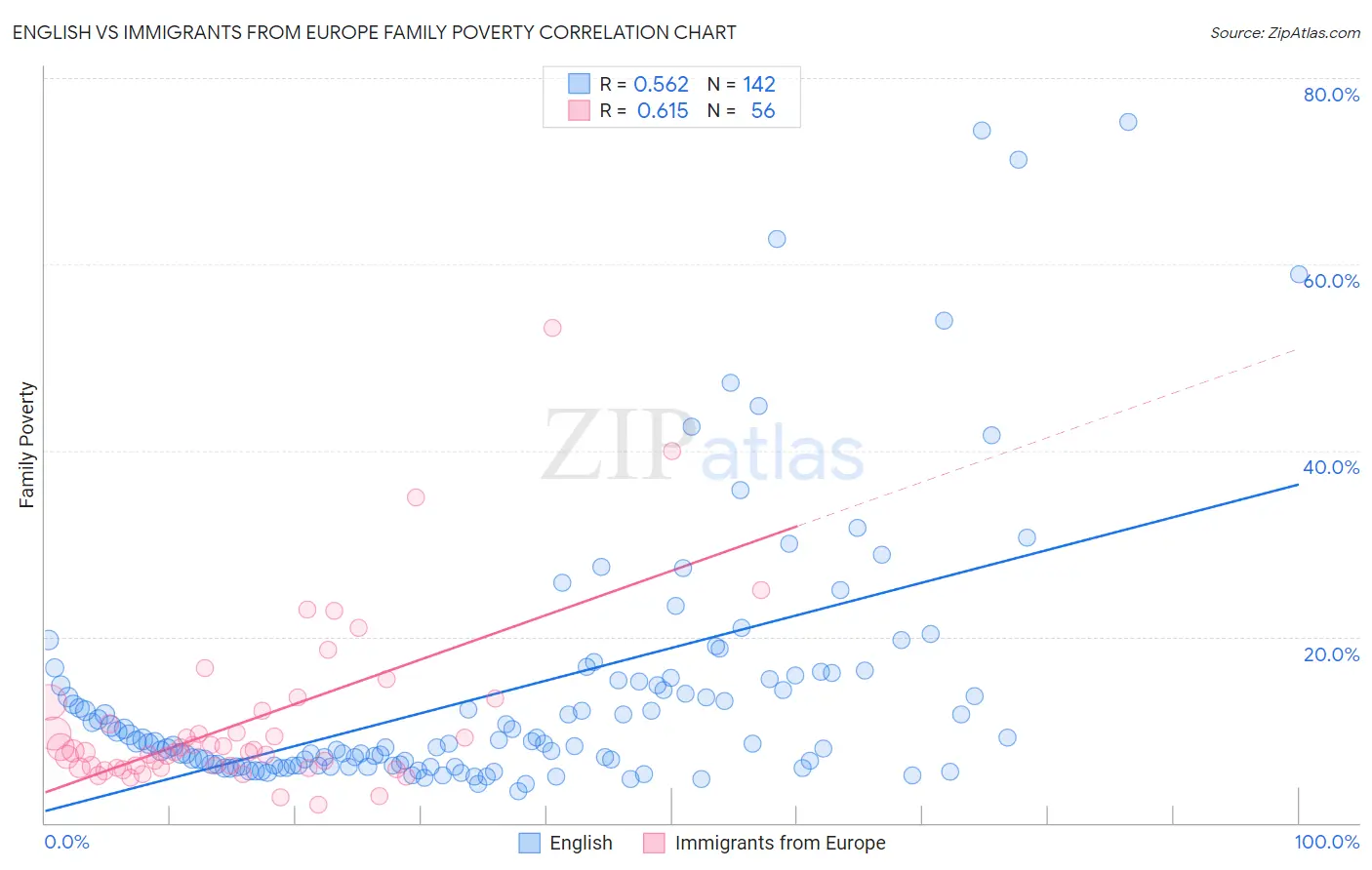English vs Immigrants from Europe Family Poverty
COMPARE
English
Immigrants from Europe
Family Poverty
Family Poverty Comparison
English
Immigrants from Europe
7.9%
FAMILY POVERTY
97.8/ 100
METRIC RATING
80th/ 347
METRIC RANK
7.9%
FAMILY POVERTY
97.8/ 100
METRIC RATING
79th/ 347
METRIC RANK
English vs Immigrants from Europe Family Poverty Correlation Chart
The statistical analysis conducted on geographies consisting of 573,938,644 people shows a substantial positive correlation between the proportion of English and poverty level among families in the United States with a correlation coefficient (R) of 0.562 and weighted average of 7.9%. Similarly, the statistical analysis conducted on geographies consisting of 543,618,397 people shows a significant positive correlation between the proportion of Immigrants from Europe and poverty level among families in the United States with a correlation coefficient (R) of 0.615 and weighted average of 7.9%, a difference of 0.060%.

Family Poverty Correlation Summary
| Measurement | English | Immigrants from Europe |
| Minimum | 3.4% | 1.9% |
| Maximum | 75.3% | 53.2% |
| Range | 71.9% | 51.3% |
| Mean | 14.1% | 10.9% |
| Median | 8.6% | 7.7% |
| Interquartile 25% (IQ1) | 6.2% | 5.9% |
| Interquartile 75% (IQ3) | 15.3% | 11.3% |
| Interquartile Range (IQR) | 9.2% | 5.4% |
| Standard Deviation (Sample) | 13.9% | 9.3% |
| Standard Deviation (Population) | 13.9% | 9.2% |
Demographics Similar to English and Immigrants from Europe by Family Poverty
In terms of family poverty, the demographic groups most similar to English are Irish (7.9%, a difference of 0.010%), Immigrants from Poland (7.9%, a difference of 0.030%), Immigrants from North America (7.9%, a difference of 0.14%), Slovak (7.9%, a difference of 0.21%), and Ukrainian (7.9%, a difference of 0.25%). Similarly, the demographic groups most similar to Immigrants from Europe are Irish (7.9%, a difference of 0.070%), Immigrants from North America (7.9%, a difference of 0.080%), Immigrants from Poland (7.9%, a difference of 0.090%), Ukrainian (7.9%, a difference of 0.19%), and Immigrants from Latvia (7.9%, a difference of 0.20%).
| Demographics | Rating | Rank | Family Poverty |
| Immigrants | Belgium | 98.2 /100 | #69 | Exceptional 7.8% |
| Immigrants | Canada | 98.2 /100 | #70 | Exceptional 7.8% |
| Cambodians | 98.2 /100 | #71 | Exceptional 7.8% |
| Immigrants | Romania | 98.2 /100 | #72 | Exceptional 7.8% |
| Austrians | 98.2 /100 | #73 | Exceptional 7.8% |
| Immigrants | China | 98.1 /100 | #74 | Exceptional 7.8% |
| Immigrants | Croatia | 98.1 /100 | #75 | Exceptional 7.8% |
| Immigrants | Latvia | 98.0 /100 | #76 | Exceptional 7.9% |
| Ukrainians | 98.0 /100 | #77 | Exceptional 7.9% |
| Immigrants | North America | 97.9 /100 | #78 | Exceptional 7.9% |
| Immigrants | Europe | 97.8 /100 | #79 | Exceptional 7.9% |
| English | 97.8 /100 | #80 | Exceptional 7.9% |
| Irish | 97.8 /100 | #81 | Exceptional 7.9% |
| Immigrants | Poland | 97.8 /100 | #82 | Exceptional 7.9% |
| Slovaks | 97.7 /100 | #83 | Exceptional 7.9% |
| British | 97.5 /100 | #84 | Exceptional 7.9% |
| Immigrants | Asia | 97.4 /100 | #85 | Exceptional 7.9% |
| Scottish | 97.3 /100 | #86 | Exceptional 7.9% |
| Belgians | 97.3 /100 | #87 | Exceptional 8.0% |
| Serbians | 97.2 /100 | #88 | Exceptional 8.0% |
| Immigrants | Denmark | 97.1 /100 | #89 | Exceptional 8.0% |